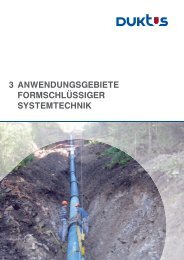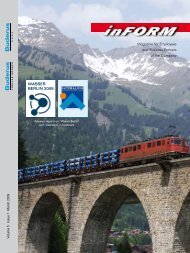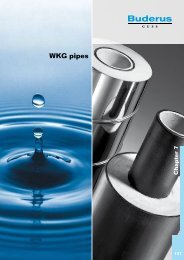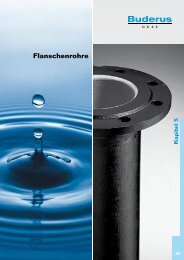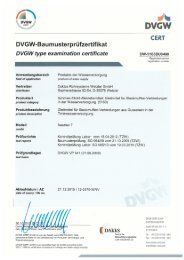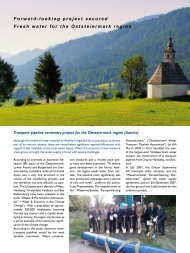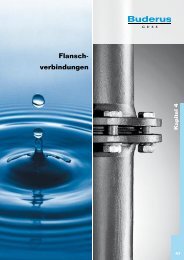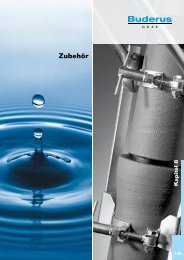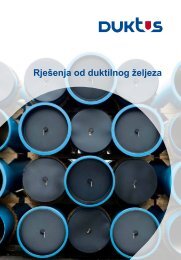Cast Iron Pipe Technology - Duktus
Cast Iron Pipe Technology - Duktus
Cast Iron Pipe Technology - Duktus
You also want an ePaper? Increase the reach of your titles
YUMPU automatically turns print PDFs into web optimized ePapers that Google loves.
The Spirit of the Original<br />
<strong>Cast</strong> <strong>Iron</strong> <strong>Pipe</strong> <strong>Technology</strong>
2<br />
THE SPIRIT<br />
The company<br />
Quality is our tradition -<br />
Buderus cast iron pipes for more than 100 years<br />
Buderus has been producing pipes in Wetzlar<br />
since 1901. In the beginning cast iron pipes were<br />
produced using the sand-casting process. As one of<br />
the fi rst pipe manufacturers, Buderus adopted the<br />
tube spin-casting process from Lavaud in 1927. And<br />
today Buderus is one of the leading manufacturers<br />
of ductile cast iron pipes in Europe.<br />
Buderus Gussrohrtechnik represents highest<br />
quality and state-of-the art production. It stands<br />
for fl exibility and responsibility, which starts with<br />
engineering consultations for projects and continues<br />
in production and support on the construction<br />
site where the pipes are installed. <strong>Cast</strong> iron pipe<br />
technology is supported by a team of qualifi ed<br />
employees, who assume the responsibility for<br />
their products – the pipes and their connections<br />
– by utilizing their ideas, the capabilities in applying<br />
the material and their knowledge about pipe<br />
constructions.<br />
Buderus Gussrohrtechnik uses a quality<br />
management system certifi ed in accordance<br />
with DIN EN ISO 9001. Products and production<br />
processes are frequently monitored by the<br />
Materialprüfungsamt [material test offi ce] Nordrhein-<br />
Westfalen.<br />
Additionally, Buderus Giesserei Wetzlar GmbH uses<br />
an environmental management system certifi ed in<br />
accordance with DIN EN ISO 14001.
OF THE ORIGINAL<br />
Ductile cast iron pipe systems<br />
Ductile cast iron – an innovative material<br />
Ductile cast iron pipes are now essential for the transport of our most<br />
valuable food component, drinking water. This is a clear indicator for<br />
the outstanding characteristics of the proven material.<br />
What does ductile mean?<br />
Ductile means shapeable. Ductile cast iron material is not rigid, it can<br />
bend based on its structural condition.<br />
This makes it strong!<br />
Ductile cast iron – a tough iron-carbon material, with a carbon content<br />
that is mainly present as graphite in a free form – is a development<br />
based on grey cast iron, which was used in the past.<br />
In contrast to grey cast iron, which contains the free graphite in lamina<br />
shape, the ductile, shapeable cast iron contains graphite spheres<br />
– the spherolites – which positively infl uence the characteristics of the<br />
primary structure. This increases the strength characteristics of ductile<br />
graphite iron in comparison to grey cast iron.<br />
3
PIPES AND FITTINGS<br />
4<br />
Socket pipes made from ductile cast iron for<br />
drinking water and waste water<br />
High strength and extreme overlap<br />
Root resistant<br />
Integrity even at high internal pressures,<br />
vacuum and high ground water levels<br />
High cost effectiveness due to long product<br />
life<br />
Defl ection of the connections up to 5°,<br />
depending on the nominal diameter<br />
Socket pipes made from ductile cast iron for<br />
drinking water and waste water with cement mortar<br />
lining (ZMU)<br />
High mechanical strength<br />
Can also be used in soils with rock content<br />
(up to 100 mm diameter) and for strongly<br />
aggressive soil conditions<br />
Soil exchange is not necessary, excavation<br />
soil must not be removed<br />
Socket pipes made from ductile cast iron for<br />
drinking water and waste water can be delivered in<br />
accordance with the following external protection<br />
types:<br />
Fittings<br />
Zinc coat with cover coating<br />
Zinc-aluminum coat with cover coating<br />
Cement-mortar coating<br />
WKG coat<br />
Other designs on request<br />
A comprehensive fi tting assortment is<br />
available to provide a complete system<br />
solution for all applications.
Plan by utilizing the capabilities of ductile cast iron<br />
pipes from Buderus.<br />
Our advantages are as certain as the ductile pipes<br />
are safe in the ground.<br />
Technical advantages<br />
<strong>Cast</strong> iron pipes can handle high static stress.<br />
Due to the TYTON ® connection, they can be<br />
deflected, they are inured against position changes,<br />
they are root resistant and they withstand high<br />
internal pressures and surrounding groundwater.<br />
Innovative internal and external coatings protect the<br />
pipes against attack by water and soil.<br />
Ecological advantages<br />
Ductile cast iron pipes are almost completely made<br />
from recycled material and are therefore recyclable.<br />
The internal lining consists exclusively of cement,<br />
sand and drinking water.<br />
Economic advantages<br />
• high installation performance due to large<br />
construction length<br />
• long product life due to innovative internal and<br />
external coatings<br />
• reuse of the excavation material for pipes with<br />
external cement-mortar coating<br />
• simple and therefore fast installation<br />
SUMMARY OF ADVANTAGES<br />
5
DRINKING WATER PIPES<br />
6<br />
Water as a strategic<br />
resource<br />
This foundation of all life is not evenly distributed in<br />
the world.<br />
The main objective is to supply people with clean<br />
drinking water. Even if you are living in an area with<br />
plenty of water, please do not waste a drop of this<br />
valuable food component.<br />
The utilization of ductile cast iron pipes for the<br />
drinking water supply ensures for many decades<br />
now that this main food component is safe and<br />
reaches the user unchanged.<br />
Functional safety and cost effectiveness are the<br />
main criteria for pipe systems made from ductile<br />
cast iron pipes. The wide application variability<br />
is another criterion or in other words, another<br />
advantage of the ductile drinking water systems.<br />
The ductile cast iron material and the TYTON ® pushin<br />
socket connections provide outstanding safety<br />
reserves to meet the requirements of a stable and<br />
long-lasting drinking water supply.<br />
Depending on the requirements, BLS ® and BRS ®<br />
push-in socket connections are available as<br />
longitudinal force-fi t push-in socket connections.
Safety, tightness, long<br />
product life<br />
Waste water must safely arrive at the treatment<br />
facilities, because clean groundwater is vital! The<br />
use of ductile waste water pipes provides you this<br />
safety.<br />
Why are ductile waste water pipes safe?<br />
Because they do not leak.<br />
Groundwater cannot penetrate the channel.<br />
Materials and connections prevent the leaking of<br />
waste water and therefore the contamination of soils<br />
and groundwater. They can absorb high external<br />
loads easily, which are caused by earth pressures<br />
and traffi c loads. They provide high safety reserves<br />
to compensate for unpredictable loads.<br />
A clear economic advantage is the extreme long<br />
product life.<br />
Waste waters are aggressive, and that is no issue<br />
for waste water pipes from Buderus, because the<br />
internal lining with high alumina cement-mortar<br />
ensures that the pipes are protected even against<br />
strongly biogenic sulfuric acid attacks.<br />
Buderus ductile cast iron waste water pipes and<br />
fi ttings can be used almost everywhere, among<br />
others as gravity lines and for pipes through drinking<br />
water protection areas.<br />
One guarantor for the safety is the TYTON ®<br />
push-in socket connection. This connection is<br />
defl ectable. It works like a joint and follows the soil<br />
movements, without transferring bending forces<br />
to the next pipe or fi ttings. And it is root resistant.<br />
The TYTON ® ensures that the pipes are protected even against<br />
Buderus ductile cast iron waste water pipes and<br />
fi ttings can be used almost everywhere, among<br />
others as gravity lines and for pipes through drinking<br />
push-in socket connection. This connection is<br />
defl ectable. It works like a joint and follows the soil<br />
movements, without transferring bending forces<br />
to the next pipe or fi ttings. And it is root resistant.<br />
push-in socket connection provides<br />
tightness against high internal pressures and against<br />
surrounding groundwater.<br />
WASTE WATER PIPES<br />
7
COATINGS<br />
8<br />
Well coated<br />
Buderus cast iron pipes for drinking water and<br />
waste water are reliably protected against external<br />
corrosion attacks.<br />
A zinc coat with cover coating or cement-mortar<br />
coating qualify the cast iron pipe for almost all<br />
existing soil types.<br />
The following coatings are available:<br />
• Zinc coat with cover coating<br />
• Zinc-aluminum coat with cover coating<br />
• Zinc coat with cement-mortar coating<br />
<strong>Pipe</strong>s with zinc coats and cover coating when used<br />
in combination with an additional heat insulation<br />
(WKG) can also be used for pipes that are subject<br />
to frost or heat losses.
Well lined<br />
<strong>Pipe</strong>s that are used for the transport of drinking<br />
water receive an internal cement mortar lining based<br />
on blast-furnace cement (HOZ), while waste water<br />
pipes are covered with a cement mortar lining based<br />
on high alumina cement (TZ).<br />
These are purely mineral linings, which consist of a<br />
cement sand water mixture.<br />
They are attached to the pipe by a rotational spin<br />
process. The bonding area is protected by an epoxy<br />
resin lining.<br />
Other internal linings available on request.<br />
LININGS<br />
9
CONNECTIONS<br />
10<br />
Good connections are<br />
important<br />
<strong>Pipe</strong> systems are used as part of the supply and<br />
disposal pipes and that is exactly the reason why<br />
pipe connections are so important. The effi ciency of<br />
the pipe depends on its reliability. Buderus uses the<br />
proven TYTON ® push-in socket connection for all<br />
ductile pressure pipes.<br />
It is root resistant and highly resistant to stress.<br />
The tightness of the pipes is also guaranteed by the<br />
TYTON ® push-in socket connections for high internal<br />
pressures, vacuums and high groundwater levels.<br />
A specially shaped sealing assumes the sealing<br />
function. The sealing consists of a soft and a harder<br />
rubber mixture. The sealing in the sealing chamber<br />
is pre-pressured after the socket has been put<br />
in place. A design coordination between sealing<br />
chamber, sealing rim and pipe diameter results in a<br />
high deformation of the sealing and therefore in a<br />
high contact pressure on the sealing surface. The<br />
harder, claw shaped ring part, which is positioned<br />
in the fastening groove of the socket, keeps the<br />
sealing in its position during the insertion of the pipe<br />
end and it provides the same service later against<br />
stress due to internal pressures.<br />
Defl ection of the connections up to 5°, depending<br />
on the nominal diameter.<br />
However, the TYTON ® push-in socket connection<br />
does not have a natural longitudinal force-fi t.<br />
The following longitudinal force-fi t designs of the<br />
TYTON ® push-in socket connection are available if<br />
the forces created by the internal pressures in the<br />
pipe cannot be absorbed by the concrete anchor<br />
block.
The longitudinal force-fi t BRS ® push-in socket<br />
connection (Buderus-Restrain-System) is a<br />
development based on the proven TYTON ® - SIT<br />
connection. The result of this development is<br />
the TYTON ® - SIT- PLUS ® connection. The BRS ®<br />
connection with its friction force fi t is highly resistant<br />
to stress due to the sealing and can therefore be<br />
used for extreme applications. The pipes with a<br />
length of 6 m can be installed in a radius a short as<br />
115 m because the push-in socket connection is<br />
defl ectable up to 3°. This reduces the requirements<br />
for fi ttings and the installation time. The innovative<br />
connection technology and the friction force-fi t of<br />
the BRS ® push-in socket connection provide a large<br />
number of advantages and application possibilities,<br />
which far exceed the application options of the<br />
TYTON ® - SIT connection.<br />
Quick overview<br />
• Replacement for concrete counter bearings<br />
• Suitable for loads of up to 32 bar<br />
• Simple and fast installation<br />
• Defl ectable up to 3°<br />
• Extensive fi ttings program<br />
The longitudinal force-fi t BLS ® push-in socket<br />
connection (Buderus-Lock-System) provides a form<br />
fi t and is highly resistant to stress, which means<br />
it can be used for extreme applications. A welding<br />
bead on the insertion end transfers the shearing<br />
force through bars to a safety chamber, which is<br />
attached to the socket. The proven TYTON ® sealing<br />
provides tightness for the connection. The BLS ®<br />
push-in socket connection is defl ectable up to 5°<br />
and is therefore superior to all other longitudinal<br />
CONNECTIONS<br />
force-fi t push-in socket connections. Narrower curve<br />
radius can be achieved during installation. These<br />
characteristics are desirable when pipe lines get<br />
installed with modern trench processes, plowed in<br />
by rocket plows or if they are installed as culvert<br />
pipes in rivers. The BLS ® connection is the optimum<br />
solution for pipes above ground, such as bridge<br />
pipes, whose connections must absorb length<br />
changes due to temperature variations.<br />
Quick overview<br />
• Replacement for concrete anchor blocks<br />
• Horizontal drilling<br />
• Plowing with the rocket plow<br />
• Trenchless exchange of pipes on the same track<br />
with the press-pull process<br />
• Burst lining process<br />
• Culvert pipes<br />
• Bridge pipes<br />
• Collector pipes<br />
• <strong>Pipe</strong> systems for snow making facilities<br />
• Turbine pipes<br />
• Fire extinguisher pipes<br />
• <strong>Pipe</strong> relining<br />
• Defl ectable up to 5°<br />
11
TRENCHLESS INSTALLATION<br />
12<br />
Trenchless construction processes for the<br />
replacement of pressure pipe systems are important<br />
for inner-city installations and culvert construction in<br />
rivers.<br />
The application shows a clearly increasing trend,<br />
because it is much more cost effective if compared<br />
to the open construction and the environmental<br />
impact is significantly lower.<br />
Ductile cast iron pipes with longitudinal force-fit<br />
BLS® connections are especially qualified for<br />
trenchless pipe installations based on their high<br />
stress-resistance.<br />
Press-pull process<br />
This process pushes the old pipe out of the ground<br />
by using a pull linkage and a special pull or pressure<br />
head, and it inserts during the same process the<br />
new ductile cast iron pipe with the BLS ® push-in<br />
socket connection and cement-mortar coating into<br />
its place. A nominal diameter increase is possible<br />
when using this process.<br />
The press-pull process provides high efficiency,<br />
speed, reliability and therefore high cost efficiency.<br />
Horizontal directional drilling<br />
The controlled horizontal drilling technology is for<br />
the last 15 years a fixture for pipe installations and<br />
many other areas. It was developed in the US in the<br />
seventieth for deep drilling applications. It is used<br />
as trenchless installation technology for pipeline<br />
constructions. The drilling technology has been<br />
accepted at a fast speed.<br />
The pipes are installed without an installation trench<br />
by using a drilling system.
PROJEKT IRGENDWO<br />
Rather than implementing extensive excavations, a<br />
pilot drill hole will first be calculated and executed.<br />
Obstacles and direction changes are not important,<br />
because the drill head tip has a functionally<br />
controlled sensor. This means that the drilling<br />
progress can be monitored and controlled.<br />
This is followed by the trenchless installation of the<br />
supply pipes. Only a start and a target excavation<br />
have to be established.<br />
Burst lining<br />
The burst lining process is an environmentally sound<br />
trenchless replacement of pipelines through the<br />
same routes. The old pipe is burst with the help of<br />
a burst head and is pressed into the surrounding<br />
soil. The resulting cavity is enlarged in such a way<br />
that a pipe with the same or a larger diameter can<br />
immediately be inserted. The burst lining is divided<br />
into a dynamic and a static process.<br />
Rocket plow process<br />
The rocket plow is used to install pipes in new<br />
routes. The rocket plow is a development based on<br />
the pipe and cable plows, which have been used for<br />
more than 30 years for the installation of cables and<br />
flexible pipes.<br />
The rocket plow process is suitable for ductile cast<br />
iron pipes up to a nominal diameter of DN 300.<br />
The components of the process are basically the<br />
pull machine with a cable winch and a plow. The<br />
most important machine part of the plow is the plow<br />
blade. The plow is connected to the pull vehicle by a<br />
steel cable. A start hole, which slopes downwards,<br />
leads the pipe to an appropriate installation depth<br />
and there it is connected to the plow blade. During<br />
this process, the plow blade thrusts the soil to the<br />
side in the area of the pipe zone due to the pull<br />
forces of the cable winch. This creates a cavity<br />
which is used to immediately install the pipe.<br />
The plow process is especially suitable for rural<br />
areas with low population densities where large<br />
pipe lengths with few connections are required. This<br />
process is currently only used for the installation of<br />
pressure pipes.<br />
<strong>Pipe</strong> relining<br />
The consumption of drinking water and therefore<br />
the generation of waste water have continuously<br />
decreased during the last years and decades.<br />
This is the reason why the long pipe lining has<br />
become more important, because smaller pipe<br />
diameters can now be utilized due to the lower<br />
water quantities. And this is why the long pipe lining<br />
is increasingly used.<br />
This process pulls or pushes ductile cast iron pipes<br />
into existing pipes that are no longer suitable for<br />
water transport. Excavations are only required at<br />
the start and at the target location. This results in<br />
relatively small efforts for civil engineering and for<br />
road construction and it has little effect on traffic and<br />
the residents.<br />
The cavity between old and new pipe can be<br />
insulated after completed installation.<br />
13
TURBINE PIPES<br />
Power from hydroelectric power plants means<br />
clean energy.<br />
Turbine pipes are often installed in extreme<br />
environments. However, a fast and safe installation<br />
is still possible with ductile cast iron pipes,<br />
because the connections guarantee good bending<br />
characteristics and the pipes can be installed without<br />
problems even if the weather is bad.<br />
The surrounding area can easily be re-cultivated,<br />
because only small trench excavations<br />
are required.<br />
The outstanding stability<br />
characteristics of the ductile<br />
cast iron pipes and the<br />
push and pull safe<br />
connections guarantee<br />
power plant pipe<br />
operations free of<br />
malfunctions.<br />
For many<br />
generations.
The lack of effi cient fi re extinguishing capabilities<br />
often results in human and economic disasters.<br />
A fi re extinguisher pipe is non-fl ammable, absorbs<br />
stress and makes water for fi re fi ghting available<br />
when needed.<br />
Due to their high safety reserves against internal<br />
pressure stresses (pressure surges) and<br />
external loads, ductile cast iron pipes are<br />
used for fi re extinguishing systems<br />
at airports, industrial facilities and<br />
street and railway tunnels. All<br />
available connection types<br />
and external protection<br />
types may be used<br />
depending on the<br />
requirement profi le.<br />
FIRE EXTINGUISHER PIPES
SNOW MAKING FACILITIES<br />
16<br />
The use of snow making facilities and therefore the<br />
guarantee that the ski slopes are ready for skiing<br />
are mandatory for attractive ski villages to ensure<br />
the most important economic factor for tourism<br />
dependent operations.<br />
The technical advantages of ductile cast iron pipes<br />
are the basis for the sales success of this special<br />
application.<br />
The basis for the effi cient functioning of a snow<br />
making facility is a safe water supply, which meets<br />
all requirements at high and medium altitudes and<br />
which can withstand very high pressures.<br />
Buderus has delivered more than 1000 snow<br />
making pipes throughout Europe during the last<br />
years. The robustness of the material, the mobile<br />
socket system and the fast and easy installation<br />
and assembly have made Buderus and its sister<br />
company, Tiroler Röhren- und Metallwerke AG, the<br />
market leader of pipes and fi ttings for snow making<br />
facilities.
Heat insulated cast iron pipes (WKG pipes) with<br />
longitudinal force-fi t push-in socket connections are<br />
used as bridge pipes.<br />
The heat insulation prevents freezing of the fl ow<br />
medium even if it does not move for a longer time.<br />
A support heating can be integrated if required.<br />
The WKG pipe system consist of pipes and<br />
socket bends (MMK, MMQ) made from ductile<br />
cast iron in accordance with DIN EN 545 (water)<br />
or DIN EN 598 (waste water) with TYTON ® pushin<br />
socket connection in accordance with DIN 28<br />
603, longitudinal force-fi t if required. The pipes<br />
are covered with a heat insulation made from<br />
FCKW free polyurethane (PUR) hard foam with an<br />
average total density of 80 kg/m 3 . For open pipes<br />
(FL), the hard foam is protected against weather<br />
related impacts by a roll fold coat pipe made from<br />
galvanized steel sheets in accordance with DIN 24<br />
145 or stainless steel. For earth covered pipes (EL)<br />
that are subject to frost, the hard foam is protected<br />
by a coat pipe made from PE-HD in accordance with<br />
DIN 8074/8075.<br />
HEAT INSULATED<br />
PIPES<br />
17
QUALITY<br />
18<br />
Certified quality<br />
management system<br />
The quality of the manufactured products and<br />
the satisfaction of the customers is the highest<br />
company goal for Buderus Gussrohrtechnik.<br />
Buderus Gussrohrtechnik uses a quality<br />
management system certified in accordance with<br />
DIN EN ISO 9001.<br />
The products and production processes are<br />
frequently monitored by the Materialprüfungsamt<br />
[material test office] Nordrhein-Westfalen.<br />
Additionally, Buderus Giesserei Wetzlar GmbH uses<br />
an environmental management system certified in<br />
accordance with DIN EN ISO 14001.<br />
The comprehensive quality assurance system starts<br />
with the chemical analysis of the raw and auxiliary<br />
materials, because the melting and the treatment<br />
of the molten iron require a very high pureness<br />
and uniformity of the raw materials, monitoring of<br />
the melting process, the stability of the chemical<br />
composition and the seeding.<br />
The pipe manufacturing process must especially<br />
monitor the solidification and shrinking<br />
characteristics of the ductile cast iron. The review<br />
of the annealed pipes must test the material<br />
characteristics, which are defined in DIN EN 545 (for<br />
drinking water pipes) and DIN EN 598 (for waste<br />
water pipes).<br />
The sockets and the insertion ends of the annealed<br />
pipes are tested with limit gauges, the wall thickness<br />
is measured with calipers. All pipes are subject to a<br />
comprehensive visual inspection for internal and external<br />
defects. Depending on the pipe and the diameter,<br />
the pipes must withstand the specified test<br />
pressures during the internal pressure test with water.
Cement-mortar lining<br />
The cement-mortar linings of the pipes are also<br />
subject to the rigorous quality controls. Depending<br />
on the nominal diameter, the required coat thickness<br />
must be met, in addition to a test of the basic<br />
materials of the fresh mortar.<br />
External coating<br />
The external coating is also subject to such a<br />
rigorous control. The ductile cast iron pipes from<br />
Buderus always receive an external coating, which<br />
consists of a zinc coat and a cover coating. It is also<br />
possible to optionally cover Class 40 pipes with<br />
a zinc-aluminum coat with cover coating (Buderus<br />
Zink-Plus ® ) to increase corrosion protection.<br />
A high quality plastic modified cement-mortar<br />
coating with a high mechanical resistance and a<br />
thickness of 5mm is available for use in strongly<br />
aggressive and rocky soils.<br />
The final inspection is performed after the pipes are<br />
marked. The material is marked as “ductile cast<br />
iron” by a parallel indentation on the inside of the<br />
socket. It is approximately 3 mm deep.<br />
19
Buderus Giesserei Wetzlar GmbH<br />
<strong>Cast</strong> <strong>Iron</strong> <strong>Pipe</strong> <strong>Technology</strong><br />
P.O. Box 1240 D-35573 Wetzlar<br />
Phone: +49 (0) 64 41 - 49 22 60<br />
Fax: +49 (0) 64 41 - 49 16 13<br />
E-mail: manfred.hoffmann@gussrohre.com<br />
www.gussrohre.com<br />
BGW/RV • 112 • 03/06 • e 2 000 • DN



